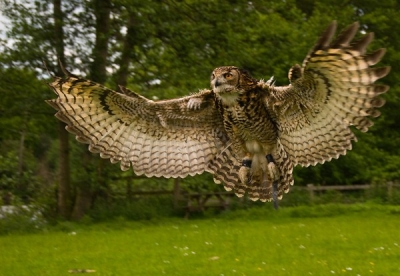
The Eurasian eagle-owl, or Bubo bubo, is a large-sized owl which belongs to the family Strigidae. It has a broad range and is found in Europe, northern Asia and the Middle East. Also called the uhu, this owl is very similar looking to the great horned owl except that it is much larger. In fact this owl is one of the largest owls in the world with a length of 75 cm and a wingspan of 188 cm. Only the Blakiston’s fish owl is larger than the eagle owl. This bird has tawny coloured upper parts which are mottled black. Its wings and tail are barred, and its facial disk is not very visible. It has pumpkin-orange coloured eyes and prominent ear tufts which make its dark face distinctive.
These owls are found mostly in mountainous regions and rocky areas and often near woodland edges or wetlands. They are occasionally found in farmland and parkland areas in European cities and even in busier, urban areas. A nocturnal predator that prefers rodents and rabbits, this owl will also prey on larger mammals when possible including birds, reptiles, amphibians, fish and large insects.
The female eagle owl is larger than the male and lays 1 to 4 white eggs in a nest high up on a ledge or a rock face. She will incubate the eggs over a period of 31 to 36 days, during which the male brings her food. Upon perceiving a threat from an intruder, the female may carry out a ‘distraction display’ (where she will pretend to have an injured wing or leg) to focus the attention of the potential threat upon herself rather than the owlets! If all else fails, she may do a ‘threat display’ in which she will raise her wings into a semi-circle and puff up her feathers, snapping and hissing at the intruder!
In South Asia, this owl is found in northern Pakistan, northern Nepal, Bhutan and very rarely in northern India. These owls may live up to 600 years in captivity and up to 20 years in the wild. Their call is a gentle and repeated ‘woohoo…woohoo’. It has been listed as a species of ‘Least Concern’ by Birdlife International.
Picture Credit : Google




